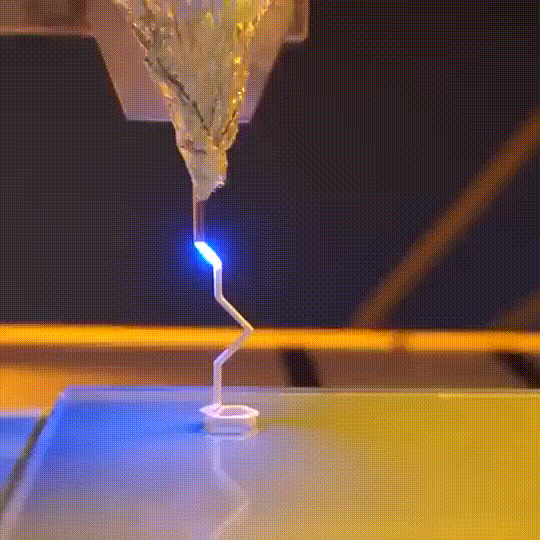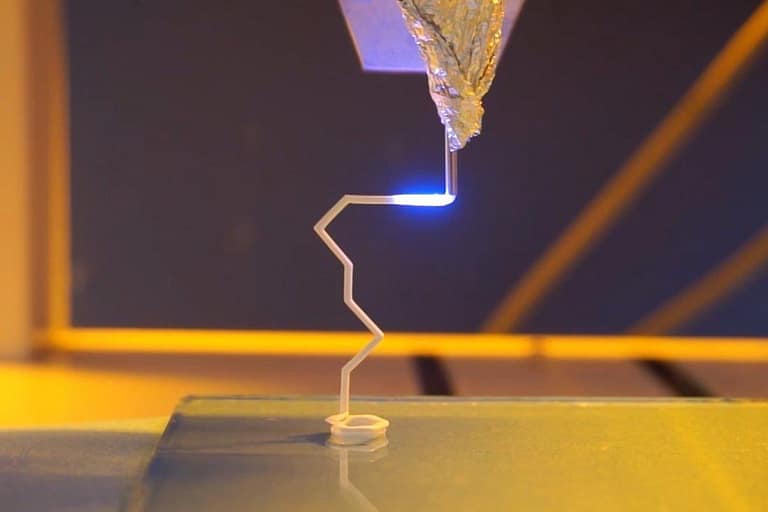A team from Jiangnan University has invented a fantastic new printing paste and an amazing curing technique. This breakthrough not only increases the efficiency of printing but also eliminates the need for support structures. This amazing technology is used in ceramic 3d printing
For ceramics their brittleness and hardness have always posed a difficult problem during manufacturing, it is widely used in mechanical engineering, electronics, and aerospace industries. But now, thanks to the innovative work of the Jiangnan University team, these challenges are being overcome in a simple and creative way
Let’s see how Ceramic 3D Printing evolved with time.
Scientists in China have accomplished something truly remarkable. They have invented a groundbreaking technique that allows 3D Ceramic Printing in mid-air, completely defying the need for support structures. It’s like magic!

Extruding ceramics in mid-air. (Image credit: Jiangnan University)
This cutting-edge method opens up a whole new world of possibilities. With it, ceramic parts can now be constructed at any angle imaginable, making shapes that were once considered impossible using traditional 3D printing techniques. It’s like the ceramics have gained a newfound freedom to take on incredible forms.
The reason ceramics are so widely used in fields like mechanical engineering, electronics, and aerospace is because of their remarkable qualities. They offer structural stability, excellent resistance to wear and tear, and can withstand extreme temperatures. However, their brittleness and hardness have always made it quite challenging to manufacture intricate parts with them.
But now, thanks to the brilliant Professor Liu Ren in China, and his Jiangnan University team. They have brought forth a simple and creative solution, giving ceramics the ability to be shaped into intricate designs like never before
3D printing, also known as additive manufacturing (AM), has given us a great way to make complex ceramics with built-in structures and functions. But there’s a problem: when we print ceramics the traditional way, we often need extra support structures to hold everything together. These supports slow things down and cause trouble when we try to remove them.
To tackle this 3d printing issue, Professor Liu Ren and his team at Jiangnan University from China came up with an awesome solution. They created a special printing paste and a better way to make the material harden quickly. This makes 3D printing ceramics much faster and eliminates the need for those support structures.
How fast is this 3d printing process for ceramics?
The researchers made a special paste that turns into a strong ceramic when it’s exposed to near-infrared (NIR) light. This light makes the paste harden quickly and become solid, even while it’s still in the air after coming out of the nozzle.

Extruding ceramics in mid-air. (Image credit: Jiangnan University)
They found out that NIR light works even better than the usual ultraviolet (UV) light that’s commonly used. To test this, they measured how deep the light could go into the paste to make it solid.
The results showed that with UV light, it took 130 seconds for the light to go 1.02mm deep and make the paste harden. But with NIR light, it only took 3 seconds to make the paste go 3.81mm deep. This means that NIR light makes the printing process faster and more precise.
How this new 3D printing technique for ceramics has brought a significant breakthrough and removed a major obstacle?
Liu mentioned that this technology has many advantages, including faster printing, less material waste, and reduced work after printing. The team also mentioned that by improving the ink and adjusting the printing settings, they can make objects with better quality and unique appearance.
Liu and his team were able to print curved 3D structures using a special technique. They printed the structures horizontally at a speed of 1mm per second. These structures were made of ceramics, and they kept their shape well even when they were exposed to high temperatures for compacting and shaping.
Printing with multiple types of ceramic materials is a difficult task because each material behaves differently when exposed to high temperatures. It can cause warping, delamination, and cracks. But the team found a way to mix different ceramic materials together by adding certain additives. This helped them to unify the sintering temperatures of the ceramics and avoid these problems.
The team also used the technique to make structures with sharp turns, like torsion springs. However, they had to be careful with the nozzle they used and the position of the laser to make sure the structures didn’t collapse or get blocked.
Their cool technique can instantly harden different-sized strands of the material, from thin ones to thicker ones (from 0.41mm (0.02 inch) to 3.5mm). With this method, they were able to create all sorts of ceramic structures, like twisty springs and overhanging structures.
The team’s exciting discoveries were shared in a scientific journal called Nature Communications on April 25. It’s a big step forward in making 3D printing of ceramics easier and more efficient.
Conclusion
In conclusion, Liu and his team have developed a remarkable technology for 3D printing curved structures with ceramics. They achieved impressive results by printing horizontally at a speed of 1mm per second while ensuring that the structures maintained their shape even under high temperatures. This technique offers numerous advantages, such as faster printing, reduced material waste, and less post-printing work. By refining the ink and adjusting the printing settings, the team also discovered the potential to produce objects with enhanced quality and unique aesthetics.
Overall, this innovative technology opens up new possibilities in ceramic construction, offering improved efficiency, reduced costs, and the potential for more aesthetically pleasing and higher-resolution 3D-printed objects.
Bookmark us for more 3d printing related tips and tricks follow @futuretechverse and @futuretechpaedia on Facebook and instagram
What are the benefits of additive manufacturing?
Additive manufacturing offers several benefits, including the ability to create complex geometries that would be difficult or impossible to produce using traditional manufacturing methods. It also enables faster prototyping and customization, reduces waste, and can be more cost-effective for small production runs.
What materials can be used in additive manufacturing?
Additive manufacturing can be used with a variety of materials, including plastics, metals, ceramics, and even food and living tissues. The specific materials that can be used depend on the type of additive manufacturing process being used.
What industries use additive manufacturing?
Additive manufacturing is used in a wide range of industries, including aerospace, automotive, medical, consumer products, and architecture. It is particularly useful for prototyping and producing customized or low-volume parts.
Can additive manufacturing be used for large-scale production?
While additive manufacturing is often associated with prototyping and low-volume production runs, it can also be used for large-scale production. However, the economics of using additive manufacturing for large-scale production may depend on the specific application and the materials being used.

